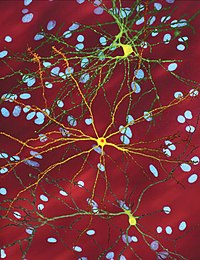
Photo from wikipedia
Huntington’s disease (HD) is characterized by clinical motor impairment (e.g., involuntary movements, poor coordination, parkinsonism), cognitive deficits, and psychiatric symptoms. An inhered expansion of the CAG triplet in the huntingtin… Click to show full abstract
Huntington’s disease (HD) is characterized by clinical motor impairment (e.g., involuntary movements, poor coordination, parkinsonism), cognitive deficits, and psychiatric symptoms. An inhered expansion of the CAG triplet in the huntingtin gene causing a pathogenic gain-of-function of the mutant huntingtin (mHTT) protein has been identified. In this review, we focus on known biomarkers (e.g., mHTT, neurofilament light chains) and on new biofluid biomarkers that can be quantified in plasma or peripheral blood mononuclear cells from mHTT carriers. Circulating biomarkers may fill current unmet needs in HD management: better stratification of patients amenable to etiologic treatment; the initiation of preventive treatment in premanifest HD; and the identification of peripheral pathogenic central nervous system cascades.
Journal Title: International Journal of Molecular Sciences
Year Published: 2023
Link to full text (if available)
Share on Social Media: Sign Up to like & get
recommendations!